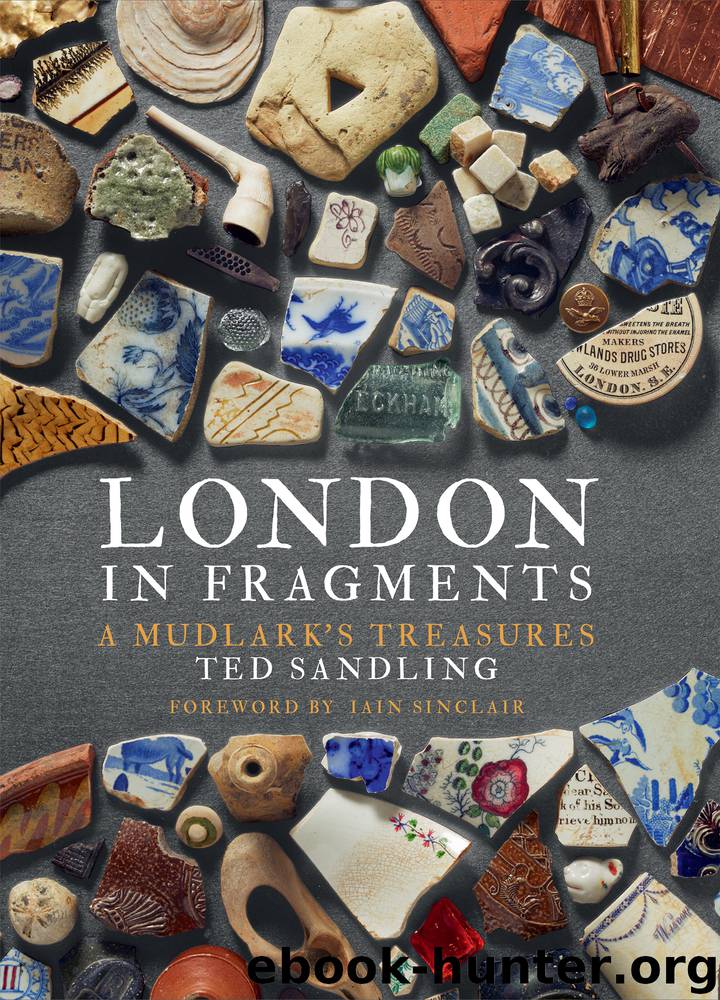London in Fragments by Ted Sandling

Author:Ted Sandling
Language: eng
Format: epub
Publisher: Frances Lincoln
Published: 2016-01-07T16:00:00+00:00
CRUCIBLE
Morgan Crucible Company
Battersea, London
Probably twentieth century
A just-decipherable ‘Morgan’ reveals this fragment to be an important link to London’s industrial heritage. It comes from the Morgan Crucible Company, a company that revolutionised the foundations of international industry and physically changed the profile of the River Thames. Crucibles are at the bedrock of all industry: they are the vessels used to melt metal.
The company was founded in 1856 by six Morgan brothers (from a family of ten) who had come to London from the Welsh village of Glasbury-on-Wye. They began as an import/export business, but one of the items they offered, an American crucible, was so successful they licensed the rights to make it. They opened a small factory in an old pottery works by the river in Battersea and called it The Patent Plumbago Crucible Co. Plumbago is graphite, not a variant of lumbago: the name means lead-like, from the latin plumbum.
The Morgans’ crucibles had a dramatic impact on the purity and efficiency of their users’ productions. Competitors’ crucibles would shatter unpredictably from heat-shock. The Morgans’, made from a mixture of graphite and ceramic, lasted longer, never broke, and according to an 1859 advert of theirs, saved ‘more than 50 per cent in time, labour, fuel and waste’. By 1862 the crucibles were being used by the Royal Mint as well as the Mints of India, France, Russia and Australia.
The factory grew so much they embanked the river, bringing the works out over the foreshore mud. Their clocktower, Ted Morgan’s Folly, became a feature of the view. Whistler painted it in Nocturne in Blue and Silver (1878), a dark reflection of the Thames now part of the White House collection.
The company diversified, first into making parts for electric motors that were used in trams and electric railways throughout the world. By the middle of the twentieth century Morgan components were found at the centre of a huge array of industrial operations. And then, in the 1970s, the company outgrew London and moved with romantic circularity back to Wales. The Battersea factory was demolished, even Ted Morgan’s Folly. During my research, I realised that I once had dinner where the glowing clock had stood. It is now Richard Rogers’ mountain of glass, Montevetro. The host, a Swiss banker.
Today, Morgan Advanced Materials is a vast corporation manufacturing everything from ceramic armour for military vehicles to parts for jet engines. They still make crucibles.
Download
This site does not store any files on its server. We only index and link to content provided by other sites. Please contact the content providers to delete copyright contents if any and email us, we'll remove relevant links or contents immediately.
| Africa | Americas |
| Arctic & Antarctica | Asia |
| Australia & Oceania | Europe |
| Middle East | Russia |
| United States | World |
| Ancient Civilizations | Military |
| Historical Study & Educational Resources |
Room 212 by Kate Stewart(4988)
The Crown by Robert Lacey(4702)
Endurance: Shackleton's Incredible Voyage by Alfred Lansing(4648)
The Iron Duke by The Iron Duke(4265)
The Rape of Nanking by Iris Chang(4116)
Joan of Arc by Mary Gordon(3997)
Killing England by Bill O'Reilly(3936)
Say Nothing by Patrick Radden Keefe(3863)
I'll Give You the Sun by Jandy Nelson(3338)
Shadow of Night by Deborah Harkness(3272)
Hitler's Monsters by Eric Kurlander(3251)
Mary, Queen of Scots, and the Murder of Lord Darnley by Alison Weir(3128)
Blood and Sand by Alex Von Tunzelmann(3112)
Darkest Hour by Anthony McCarten(3052)
Eleanor & Park by Rainbow Rowell(3023)
Margaret Thatcher: The Autobiography by Thatcher Margaret(3016)
Red Famine: Stalin's War on Ukraine by Anne Applebaum(2854)
Book of Life by Deborah Harkness(2844)
The One Memory of Flora Banks by Emily Barr(2766)
